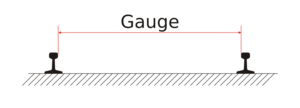Rail gauge facts for kids
Rail gauge is the distance between the two rails on a railroad track. Imagine looking at a train track: the gauge is the space from the inside edge of one rail to the inside edge of the other. This distance is super important because it decides what trains can run on the track!
Contents
What is Rail Gauge?
Rail gauge is simply the measurement of how far apart the rails are. This measurement is taken from the inside edges of the two rails. It's a key part of how railways work. If the gauge is wrong, a train can't stay on the tracks!
Different Sizes of Tracks
Not all train tracks are the same width. There are a few main types of rail gauges:
Standard Gauge
The most common track size around the world is called standard gauge. It measures 1,435 millimeters (which is about 4 feet, 8 and a half inches). Many countries, including the United States, Canada, and most of Europe, use this size. It helps trains from different places travel easily across borders.
Broad Gauge
Tracks that are wider than standard gauge are called broad gauge. An example is 1,676 millimeters (about 5 feet, 6 inches). Broad gauge tracks can sometimes allow for bigger, heavier trains. They might also be more stable for very fast trains. Countries like India and Russia use broad gauge for some of their railways.
Narrow Gauge
Tracks that are narrower than standard gauge are called narrow gauge. These can be 762 millimeters (about 2 feet, 6 inches) or even 610 millimeters (about 2 feet). A common narrow gauge is the metre gauge, which is 1,000 millimeters (about 3 feet, 3 inches). Narrow gauge tracks are often cheaper to build. They are also easier to lay in mountains or places with tight turns. You might find them in smaller, local railways or industrial areas.
Where Different Gauges Meet
Sometimes, different types of rail gauges meet at the same place. This spot is called a break of gauge. When a train reaches a break of gauge, it can't just keep going. Passengers and cargo usually have to switch to a different train that fits the new track size. This can make travel slower and more complicated. Engineers have tried different ways to solve this, like special wheels that can change width, but it's still a challenge.
Images for kids
-
Cross-section of triple-gauge track at Gladstone and Peterborough, South Australia, before gauge standardisation in 1970 (click to enlarge)
-
Mixed gauge track at Sassari, Sardinia: 1,435 mm (4 ft 8 1⁄2 in) standard gauge and 950 mm (3 ft 1 3⁄8 in)
-
Reconstructed mixed-gauge, 1,435 mm (4 ft 8 1⁄2 in) standard gauge / 7 ft 1⁄4 in (2,140 mm) track at Didcot Railway Museum, England
-
Narrow gauge work train in an East Side Access cavern where standard gauge station for the Long Island Rail Road is nearing completion.
See also
 In Spanish: Ancho de vía para niños
In Spanish: Ancho de vía para niños








